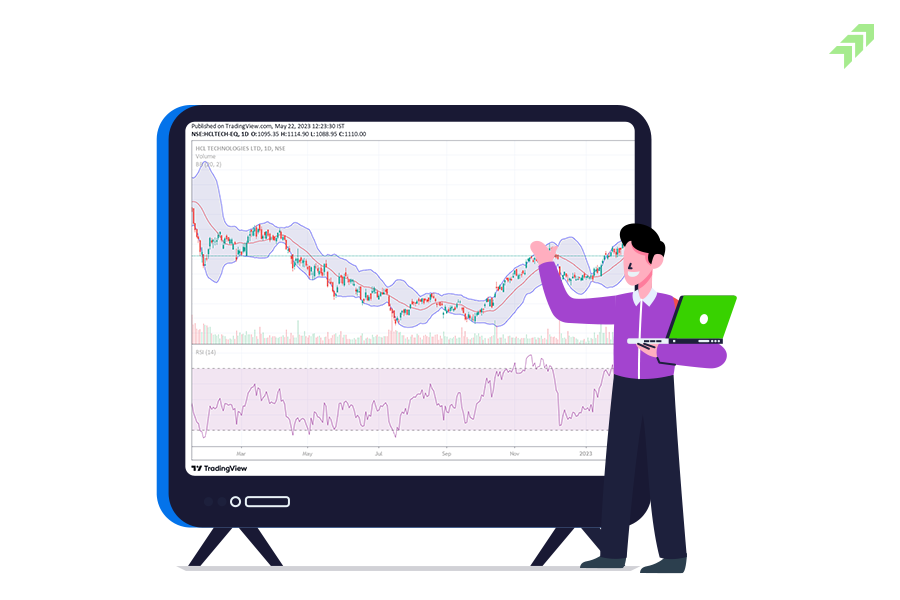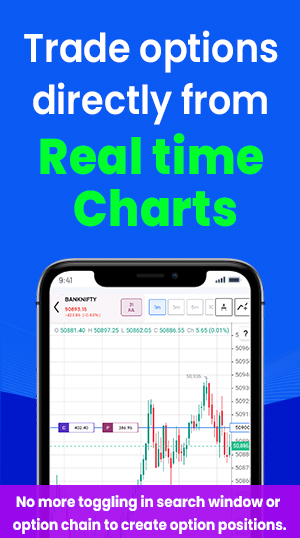Intraday trading is not only challenging but also very risky and highly rewarding for traders. But if you are using the right technical indicators while performing the technical analysis, precisely identifying the trend and finding the best stock with the right level of entering and exiting into the trade position for intraday your trading strategy can be successful. Hence choosing the right technical indicator for intraday is another challenge for the traders.
In TradingView you can find number of indicators based on pivot points to EMA that you can use for intraday trading. But here we will talk of among the best and most widely used for day trading. We will today discuss about the use of Bollinger bands and how a trader can use it for intraday with the best settings and strategy.
What are Bollinger Bands in Trading?
The Bollinger bands are the combination of three bands and the expansion and contraction of these bands reflects the volatility in the underlying security. When the Bollinger Bands expands and moves away from each other it shows the volatility is high in the market.
Also Read: How to Trade in High Volatile Market: Best Trading Strategies
On the other hand, contraction in the Bollinger Bands indicates that the volatility has been lowered. Standard deviation is used to gauge volatility in an underlying; so, the bands move according to the variations in the volatility levels. But in trading, Bollinger Bands is a quite helpful tool; if used with the correct strategy, you can even utilize it for intraday trading.
Using Bollinger Bands for Day Trading
If you understand the relevance of this indicator since the Bollinger band continuously expanding and contracting to indicate the degree of the volatility, then you can use it in day trading or intraday trading. This volatility factor might help you decide whether to buy or sell in specified market conditions for intraday trading.
Also Read: How to Select Stocks for Intraday: 10 Tips to Pick Best Stocks
The Bollinger bands can be utilized as the support and resistance levels, making it easy to decide when to take entry and exit positions in your trading strategy. To use the Bollinger Bands for intraday trading, though, you must adjust the settings and trade under specific strategies. So, let's find out how to use or apply this signal more efficiently in intraday to achieve the greatest outcomes.
How to use Bollinger Bands for Day Trading or Intraday?
For intraday trading, you need a technical indicator that gives support to your judgement on the the trend of stock for the day and the best probable entry and exit points. One can get such indication from the bollinger band expansion and contraction. Still, combining the Bollinger band with additional technical indicators will provide you superior trading insights.
Bollinger Bands Intraday Settings
The Bollinger bands are calculated based on the moving averages and 20 days simple moving average is considered. With the help of this moving average, the standard deviation is calculated to find out the value of the upper band and lower band in the Bollinger.
Also Read: How To Use Best Moving Averages for Intraday or Day Trading
The value of the standard deviation is chosen as per the timeframe of your trading strategy. Here you can tune the Bollinger band settings for intraday trading. However, for swing trading, the moving average is set for longer time frame at 50 and 200. While the standard deviation for both these trading strategies is set at 2.5 to get a medium-term view.
For short-term trading strategies, you have to set both moving averages and standard deviations at the lower levels. For scalping, the moving average is taken for 9-10 days and the standard deviation is set at 1.5. And for the day trading, you need to set the moving average at 20 and the standard deviation is considered at 2 for better results.
Bollinger Bands Intraday Trading Strategy
Now after tuning your Bollinger band values, you have to choose the right trading strategy that suits you from the intraday trading point of view. Using the Bollinger bands for intraday trading you have to follow the rules and principles that work for intraday. In day trading you have to consider various things while using the Bollinger band to perform the technical analysis and use the power of this indicator for following strategies.
Also Read: How to Do Intraday Trading: Best Stocks, Charts & Strategies
Using the Volatility
The three bands in the Bollinger bands give the overview of the volatility in the market or price of individual stock. When the bands expand the volatility is high, while the contraction of the bands means the market is less volatile in nature. You can use these bands to understand the current sentiment and sensitivity of the price movement of the market.
Also Read: How to Use Implied Volatility in Options Trading: Strategies
Breakouts and Breakdowns
The movement of a market or stock price keeps moving around or beyond these bands. When the price crosses or surges through the upper band, it is an indication of potential breakouts, giving the buying opportunity for the traders looking to go long in intraday.
Also Read: What is Breakout & Breakdown How to Identify Breakout in Stocks
On the other hand, when the price drops and breaks down below the lower bands, it is a type of retracement giving the signal of not entering into any long trade position, instead going for the short selling and taking this trading opportunity for the intraday trading.
Using the Trend Following
Day traders can use Bollinger bands as trend following indicator. In this strategy, you have to go long when other traders are buying and go short when other traders go for short-selling. This is like making hay while the sun shines.
Also Read: How to Find Trending Stocks for Intraday Trading: Ten Rules
In this trend-following trading strategy, you have to keep an eye on the upper and middle while following the uptrend and keep watching the lower and middle band, while following the downtrend. Here the trading idea is price moves with the Bollinger Bands.
Squeezing of Bollinger Bands
Apart from giving the signal of low volatility in the market, when Bollinger bands squeeze, it also gives the signal of breakout in either direction. This means the price cool downs, trading activities or volume is less, and you should wait for the next signal before entering into a day trading position. When there are significant activities, you can enter into trade.
Using the Mean Revert
Bollinger bands keep contracting or expanding depending on the different market conditions. Here you can check the swing of bands if there is extreme fluctuation with the anticipation of moving back to the central bands or central moving average. Here you can make trade decisions for day trading but it will work when the volatility in the market is high.
Weakening of the Band
After a strong movement, when the strength of the band cools down you can use this moment as a trading opportunity. Yes, when the price moves closer to the upper and lower band, mainly after a strong movement, you can consider the dwindling of the band for taking short-term trade positions in the reverse direction. However, there could be a risk of entering into such trades, but before you take any final decision confirm with other technical indicators.
Also Read: Top 5 Best Technical Indicators for Intraday or Day Trading
Using for the Trend Reversal
For the intraday trading strategy, you can use the Bollinger band as the indication of a trend reversal. Yes, when the stock moves closer to the upper band, keep watching and wait for its next movement, as there could be reversal of current trend.
Also Read: What are the Best and most Accurate Trend Reversal Indicators
When the stock price forms a parabolic type graph and opens with the gap-up and closes at the lowest price but trading outside the bands, it can be considered as an indication of correction in the stock price. And based on this indication you can enter into a trade position.
Using Bollinger Band with RSI
For intraday trading, you can also use the RSI with the Bollinger bands to know the divergences. When the market moves with higher highs, while the RSI indicator shows lower highs, it is recognized as a bearish divergence. When the market makes lower lows, while the RSI indicator shows a higher low, it is recognized as a bullish divergence.
Also Read: How to Add & Use RSI Indicator in TradingView: RSI Settings & Strategy
Here Bollinger bands will help you to identify the values visible on the chart areas. But this is not enough or you will be not able to find whether the move is strong or weak for trading. But when you also collaborate with RSI, you can get a better view.
Bollinger Bands with Double Bottoms
To use this strategy for intraday you have to recognize the formation of the Bollinger band while the volume is very high and a sharp pullback in price that closes outside the lower Bollinger bands. This kind of movement in the price is recognized as the "automatic rally". This rally works like the first level of resistance in the base-building process before showing the next moves.
Also Read: How to Select Stocks for Intraday One Day Before: 10 Tips
Here you have to keep watching, if the rally starts and the price touches the newest lows so that it can touch the strength of the pressure of buying that is generated at the bottom. As per the Bollinger Bands rules, the reset bar should be visible inside the lower band.It shows the downside pressure is decreasing, and buyers are dominating over sellers. And make sure the volume also plunged sharply when considering the Bollinger Band's situation for intraday.
Also Read: Best Volume Indicators for Day Trading & How to Use for Intraday
Summing-up
The movement of three bands in the Bollinger bands indicators helps to identify the level of volatility when there is expansion and contraction of the bands from each other. The standard deviation and moving averages are taken into account to calculate the Bollinger band values. And you have to adjust the Bollinger bands parameters as per your trading strategy.
Also Read: Short Term trading v/s Intraday trading: which one is more profitable
Once you have set the Bollinger bands from the intraday trading point of view, you can trade with Bollinger bands intraday trading strategy like using the volatility factor, squeezing of bands, mean revert, strengthening or weakening of bands and Bollinger bands with double bottoms and RSI. However, you can also use various other popular technical indicators in combination with Bollinger bands to get a better view and analysis of the market.
Also Read: How to Identify Momentum Stocks for Intraday Trading: 8 Tips
And best ways to use such technical indicators in trading find the best discount brokers in India like Moneysukh. Here you will get the best online trading platform with different types of trading strategies recommended by the market exports with the best entry and exit points in intraday trading and delivery-based positional trading at the lowest brokerage charges.
Also Read: What are the Best Entry and Exit Indicators in TradingView



















